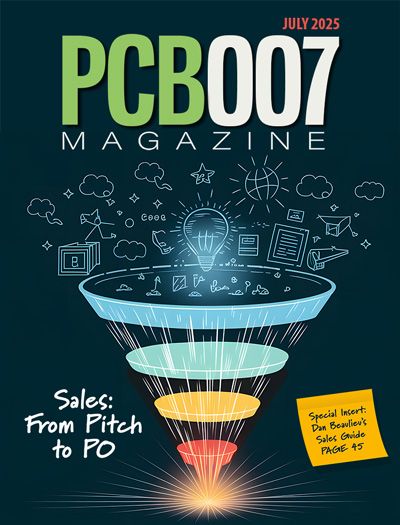-

- News
- Books
Featured Books
- pcb007 Magazine
Latest Issues
Current Issue
Advancing the Advanced Materials Discussion
Moore’s Law is no more, and the advanced material solutions to grapple with this reality are surprising, stunning, and perhaps a bit daunting. Buckle up for a dive into advanced materials and a glimpse into the next chapters of electronics manufacturing.

Inventing the Future With SEL
Two years after launching its state-of-the-art PCB facility, SEL shares lessons in vision, execution, and innovation, plus insights from industry icons and technology leaders shaping the future of PCB fabrication.

Sales: From Pitch to PO
From the first cold call to finally receiving that first purchase order, the July PCB007 Magazine breaks down some critical parts of the sales stack. To up your sales game, read on!
- Articles
- Columns
- Links
- Media kit
||| MENU - pcb007 Magazine
Additive Manufacturing Requires Additive Design Techniques
May 9, 2022 | Luca Gautero, SUSS MicroTecEstimated reading time: 2 minutes
Although I am not a designer by trade, I want to share my thoughts on what additive manufacturing means for designers, especially how it relates to solder mask. I feel the following topics are the most important to address.
1. Definition of Solder Mask
By its nature, the definition provided by any EDA tool is a negative one; the CAM vector files specify what goes away from an assumed continuous surface. Until now, solder mask has always presented itself as subtractive. SUSS MicroTec developed a front end, JETxSMFE, that can operate at the CAM station to smooth out manufacturing. The software understands all of this, managing the details correctly on the incoming files.
2. The Advantage of Inkjet Solder Mask
One advantage of inkjet solder mask is to avoid any filling of holes or vias. Another way, maybe an annoyance to some, is to say that “tenting” is not possible. Still, the consensus is that solder mask-free vias improve a board’s reliability (Figure 1). The JETxSMFE removes solder mask at declared holes. Undeclared drills, which might still exist depending on the manufacturing convention on the production floor, will result in ink on the print table. This is not a big issue as a scraper easily removes excess solder mask, and alternatively, replacing the table or its liner (if present) gets the job done. However, both solutions lead to a small downtime. Long story short, if you want friends on the shop floor, be sure to have all the drills in your design.
3. The Dam Dogma
These small solder mask traces on laminate are supposed to separate two nearby copper pads. Such a pattern indicates the non-solder mask defined (NSMD) pad design choice. However, this choice involves several constraints, and these create an artificial need for narrow dams. From my earlier example, this time with numbers: Imagine two pads, 200 µm apart, nothing extreme. What is the maximum size of a dam between these two? Assuming that LDI technology is used, the dam size results from applying the state-of-the-art constraint of the technology. This 200 µm pitch decreases by the laser beam width plus the registration accuracy twice—one for each pad. Therefore, it quickly comes down to 100 µm. Any more challenging a pad distance will also make it harder to define a dam.
From this reasoning, the many requests to create 50 µm dams or less with traditional technology seem legitimate. So, what do we do with inkjet printing? Does it join the race to the last micrometer?
To find out the answers, continue reading this article in the April 2022 issue of Design007 Magazine.
Testimonial
"We’re proud to call I-Connect007 a trusted partner. Their innovative approach and industry insight made our podcast collaboration a success by connecting us with the right audience and delivering real results."
Julia McCaffrey - NCAB GroupSuggested Items
Indium to Showcase High-Reliability Solder and Flux-Cored Wire Solutions at SMTA International
10/09/2025 | Indium CorporationAs one of the leading materials providers in the electronics industry, Indium Corporation® will feature its innovative, high-reliability solder and flux-cored wire products at SMTA International (SMTAI), to be held October 19-23 in Rosemont, Illinois.
‘Create your Connections’ – Rehm at productronica 2025 in Munich
10/08/2025 | Rehm Thermal SystemsThe electronics industry is undergoing dynamic transformation: smart production lines, sustainability, artificial intelligence, and sensor technologies dominate current discussions.
Amplifying Innovation: New Podcast Series Spotlights Electronics Industry Leaders
10/08/2025 | I-Connect007In the debut episode, “Building Reliability: KOKI’s Approach to Solder Joint Challenges,” host Marcy LaRont speaks with Shantanu Joshi, Head of Customer Solutions and Operational Excellence at KOKI Solder America. They explore how advanced materials, such as crack-free fluxes and zero-flux-residue solder pastes, are addressing issues like voiding, heat dissipation, and solder joint reliability in demanding applications, where failure can result in costly repairs or even catastrophic loss.
SASinno Americas Introduces the Ultra Series
10/07/2025 | SASinno AmericasSASinno Americas has introduced the new Ultra Series, the latest generation of offline selective soldering systems. Available in two models—the Ultra-i1 and Ultra-i2—the new series is designed to meet the needs of manufacturers running small to medium batch sizes, multiple product types, and frequent line changes, while maintaining exceptional precision and process control.
Elmotec by E-Tronix to Showcase SolderSmart® TOP Robotic Soldering at The Assembly Show 2025
10/06/2025 | ELMOTECE-tronix, a Stromberg Company, is pleased to announce its participation at The Assembly Show 2025 in Rosemont, IL, October 21st through 23rd. Exhibiting under Elmotec by E-Tronix, Booth #448, the team will highlight the SolderSmart® TOP robotic soldering system, featuring live demonstrations throughout the show.


